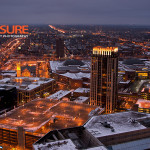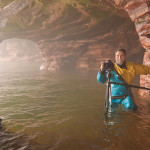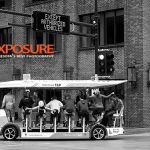WHAT GOES INTO A PHOTOGRAPH?
- SELECTION OF SUBJECT
This is perhaps the most obvious. To hold a viewer’s interest over a long time, we need an intriguing lead actor, supporting actors, a stage, and great lighting. Spend time examining your feelings about your subject. Why do you want to photograph it? What emotions do you feel? What special qualities do you want to convey?
- SELECTION OF PERSPECTIVE
Find the distance and angle (including height) that best tells your story.
- SELECTION OF FOCAL LENGTH
This process eliminates much of what we see in our peripheral vision, removing information, while putting the spotlight on what remains. This is a balancing act playing back and forth with our selection of distance to the subject.
- FINE TUNING THE CROP
Minuscule changes in the direction we aim the camera can be the difference between a great photo and a failure. Obviously, we want the subject and supporting elements to be placed in strong positions, but almost as important, is avoiding mistakes that would detract from the story. These are things like elements terminating at the edge of the frame, in corners, or against one another within the frame. With panoramic images, we can now alter the frame shape to fit content.
- PLACEMENT OF FOCUS
Getting the focus placed correctly is critical, whether we want everything sharp (overall depth of field), or only a small slice (selective depth of field).
- SELECTION OF DEPTH OF FIELD
How much do we want in focus? With digital, if everything is holding still, we can create images with infinite depth of field, very little depth of field, warped focus planes, anything we can imagine. What depth of field will best tell your story?
- SELECTION OF SHUTTER SPEED
If you are forced to handhold a camera, the limiting speed is usually around 1/focal length, for instance a 100mm lens would require 1/100th of a second of faster (vibration reduction cameras and lenses may allow a stop or two slower). If you have elements moving in the composition, shutter speed becomes a subjective, artistic choice as to how much, if any blur you wish to show. Keep in mind you can do several captures at different shutter speeds, and combine them selectively. For
example, you might wish to have a large waterfall at 1/100th, but the stream below it at 1/15th.
- EXPOSURE (light intensity x time) Controlled by shutter speed, aperture and ISO.
Like focus, digital allows for a nearly infinite dynamic range we can warp as desired.
How I expose:
I almost always have my camera set to SPOT METER, and MANUAL EXPOSURE MODE.
I place the spot on the brightest thing I have in the composition that I want detail in (not the sun or light source). Having previously selected my aperture for the desired depth of field, I then adjust the shutter speed until the meter says I’m 2 (or more if tests have confirmed you can go higher) stops over exposed (reads +2). I can then aim the spot at the darkest area to see what it reads. If it is a —3 or higher (—2 or —1), I know I can make the capture at that exposure in one capture, getting all the information needed. My exposure will put the highlights near the right side of the histogram (further right the better), with NO clipping.
If my shadow values read — 4 or below, I would then have to slow my shutter speed a stop or two and make an additional capture, repeating this until my shadow values read at least a —3. Obviously, it is best if your camera is on a tripod, and nothing is moving. You CAN later select one image as your main one for such things as moving water by clicking on that image and checking remove ghosts, when converting the stack to a 32 bit tiff.
There have been many kinds of HDR software developed to combine these bracketed images. They can create images that are somewhat natural looking all the way to the garish grunge look that many of us are sick of. Since they pretty much all rely on global corrections, they are far from satisfying, and almost never do as good a job as could be done with layers masks and a lot of time.
What most of us want is a quick way to simply make the images look like all of our other images, with a good, natural tonal gradation from black to white.
Here is the best method I’ve found for doing that:
Open all bracketed files in ACR or Lightroom and do all your normal corrections, but omit doing any local exposure corrections. Click Done. Now, with all those files highlighted, go TOOLS>PHOTOSHOP>MERGE TO HDR PRO. Select 32 bit, set the white point and click OK. SAVE AS a tiff, and close file. Now open that tiff into ACR or Lightroom and you will have access to all those amazing tools to dig out the full dynamic range from your entire original set of images! Anyone who has worked in a traditional darkroom will be utterly blown away by this technique.
Keep in mind that if when you are done, and have converted the 32 bit tiff to 16 bits [IMAGE>MODE>16 BIT], there is an area that looks funky, you can always go back and select one or more of your original RAW images and drop them on top of the completed 32 bit tiff. Then add a mask to that layer to reveal only what you want from the new layer.








